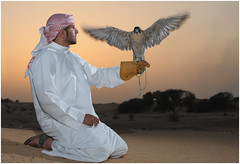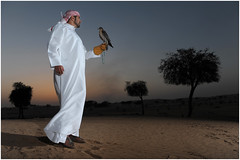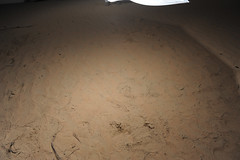
I'm back from GPP in Dubai, and (mostly) caught up on the work that always piles up at home when I am away. It was great meet new friends and to see many of the folks from last year again.
After going hard for six days straight, our treat once again was to head out into the desert to get the chance to shoot in an environment like no other.
__________
As a GPP Repeat Offender, I am now fortunate enough to have some contacts in-country. Or, rather, in-Emirates. Nigel and the guys in the Dubai Strobist group had hooked us up with Samir, who in turn hooked us up with Mostafa over at Sharjah TV, a national media outlet headquartered on the other side of the desert.
Next thing you know, we are all set to go into said desert to do a TV feature segment while shooting Omar and his falcon. I had always wanted to learn more about falconry -- right up to the point where Mostafa informed me that some of the birds can go for over a million dollars. Yet another thing that is beyond my tax bracket.
So we head off to the desert -- in a Jag, of course. I'd tell you what kind, but it was too cool to even have a model nameplate on it. It was much like my Scion XA, in the same way that Omar's falcon was much like my kid sister's parakeet.
Driving us was Hala, a supermodel masquerading as a super-producer for GPP. McNally was there, along with assistant Drew and fellow instructor Bobbi Lane. McNally, who was going to photograph Hala, learned his lesson from last year and brought along an Elinchrom Ranger. That's 1100 watt-seconds of battery-powered retinal burn -- enough to make any octabox happy in full desert sun.
Being reliably thick-headed, I went with my speedlights -- and ended up using only two. I can easily overpower the desert sun with a single speedlight -- if I get to choose the time. That's kind like waiting until Mike Tyson is 87 years old and showing up to beat the crap out of him. But as a strategy, it is very effective.
A Bird in the Hand
Fortunately, Bobbi knew all about falcons from an earlier stint at a birding facility, or falcon farm, or whatever you call it. So she was a big help in letting us know all of the stupid things not to do, which with me is a full-time job.
 So we get to the shoot location and Omar pulls out just about the most gorgeous bird of prey you could imagine. Basically, a meat-shredding machine with wings and an attitude.
So we get to the shoot location and Omar pulls out just about the most gorgeous bird of prey you could imagine. Basically, a meat-shredding machine with wings and an attitude.Our light is still six fingers from the horizon, so that tells us we have about a buck thirty, give or take, until sundown.
 First step is to scout the angles and backgrounds. I use my hand to judge how bright the sun would be on Omar and his falcon, with a Sharjah TV cameraman in tow all the while. Bobbi, meanwhile, is already making photos of Omar in the late afternoon light.
First step is to scout the angles and backgrounds. I use my hand to judge how bright the sun would be on Omar and his falcon, with a Sharjah TV cameraman in tow all the while. Bobbi, meanwhile, is already making photos of Omar in the late afternoon light.I know that I cannot hope to compete against the sun with speedlights if I soften the light form the SB's, so I set up a quick crosslight around Omar where Bobbi is busy shooting available light. Normal process -- shutter on 250th, choose an aperture that underexposes just a tad, and power back up with hard crosslight. The ambient fill sets the shadows at a manageable level.
 Only problem is, the color and surface quality of Omar's traditional Arab clothing (it is called a "kandura") is throwing back nuked gamma white from the hard strobes. I can put a dot in it in post, but mostly I am just biding my time here waiting for sunset.
Only problem is, the color and surface quality of Omar's traditional Arab clothing (it is called a "kandura") is throwing back nuked gamma white from the hard strobes. I can put a dot in it in post, but mostly I am just biding my time here waiting for sunset. The important thing is that I look like I am making good pictures. With the cameras rolling, this looks a lot better than wondering scratching my butt and around looking for camel truffles, right?
As the sun gets lower, my options start to improve. We find the spot where we will shoot Omar using the sunset as a backdrop.
 The sunset looks good dropped down a stop or two, so we grab a couple of sillos as we wait. Just because the light is not flash-friendly, there's no need to waste the time not shooting photos.
The sunset looks good dropped down a stop or two, so we grab a couple of sillos as we wait. Just because the light is not flash-friendly, there's no need to waste the time not shooting photos. I mean, seriously, how often are you in the desert with a man in traditional Arab dress and a falcon?
Next year we are going out as a group to do an overnight at one of the desert encampments, so we can actually enjoy the sunset and the cool night air that follows. When you are shooting, it all happens so fast you do not get a chance to savor it.
 As the light levels start to drop, I kept my two-hard-light setup (just bare flashes on stands) and did a little sidelight / front fill on Omar. The backdrop is the still-live sunset, and all of the subject light comes from flash. Key is off to the far right and gives shape and lighting direction.
As the light levels start to drop, I kept my two-hard-light setup (just bare flashes on stands) and did a little sidelight / front fill on Omar. The backdrop is the still-live sunset, and all of the subject light comes from flash. Key is off to the far right and gives shape and lighting direction. The fill is from a stand right next to the camera, and fills the shadows to control the contrast range without adding any new direction to the lighting. This on-axis fill, combined with a hard key gives a cool, 1950's kinda look which I am currently digging. You can see the fill shadow just to the camera left side of Omar.
 And since we are using bare light, you can really get that key light far away, too. This gives very even lighting over a large area, which makes it almost look as if it is a soundstage with a backdrop.
And since we are using bare light, you can really get that key light far away, too. This gives very even lighting over a large area, which makes it almost look as if it is a soundstage with a backdrop. One of the disadvantages of working with speedlights is you tend to have to work close. Makes for nice light, but it falls off fast. So you end up working with small framing areas. Not so when you can back those babies up.
Low Ambient = Easy Umbrella Light
As soon as the sun disappears, I know from last year that the light levels will start dropping faster than stock prices did last October. And as the ambient drops, the small lights become powerful enough to use with modifiers at reasonable power settings. This is important because the light won't last long so you don't wanna be waiting on the recycle.
We put a Westcott double-fold on one of the SB-800s. That flash will become the key light. The second is fitted with an Orbis ring flash adapter. That flash will become the on-axis fill.
Working quickly, I grab an exposure for the darkening sky behind Omar. It is dark enough now to where I can use an aperture to which my flash can easily bring up the subject.
 Since I plan to have the key light 3-4 feet over Omar's head, I grab a quick shot of the sand, lit by the key light from the same distance, to make sure my flash is set at an appropriate power setting. If this is off, I can quickly correct either by moving my aperture and compensating for the background by moving the shutter in the opposite direction. Or I can just vary the power on the flash before we put it up in the air. This is much quicker than doing the testing with the light in the final position.
Since I plan to have the key light 3-4 feet over Omar's head, I grab a quick shot of the sand, lit by the key light from the same distance, to make sure my flash is set at an appropriate power setting. If this is off, I can quickly correct either by moving my aperture and compensating for the background by moving the shutter in the opposite direction. Or I can just vary the power on the flash before we put it up in the air. This is much quicker than doing the testing with the light in the final position.
Here's the setup shot, thanks to Bobbi. The final picture is worth the trouble, but I am still washing fine, desert sand out of my butt. (Come to think of it, If Carson Kressley asks, I am exfoliating.)
We are lucky enough to have Drew, Joe's assistant, acting not as a voice-activated light stand, but rather a VAB: A voice-activated boom. The speedlights and compact stands are light, and can be used this way for reasonable amounts of time without killing an assistant. But no worries - Drew is not my assistant, so there is really no long-term downside if anything bad happens.
The Result

By dropping the light in right on top of Omar, lots of cool things start to happen. From a direction standpoint, you get fairly dramatic light on his face, which adds a nice mood. And the light is soft enough so that it wraps well, too. (Click the pic for bigger version.)
But from a distance standpoint it is also doing good stuff. Omar's face is fully lit by the close-in source, but his white kandura falls off a little as it travels away from the key light. This helps to control the tones on the bright white material in a way that we could not accomplish if lighting from a distance.
Also, as the light is right over Omar, the sand falls off nicely as it approaches the near foreground. This is a problem that you have to deal with when you light frontally. If you will remember last year, Joe did this by gobo'ing the bottom of the umbrella.
That top light is going to leave some eye socket shadows, and it will get pretty dark as you travel down the kandura. That is where the Orbis comes in. I use it not as a main, but to provide directionless, on-axis fill.
No magic ratio to report, either. Given that you have set your exposure for the key, you simply dial in the power on the Orbis fill to taste. You can see what the fill is doing in places such as Omar's eye sockets and the kandura under his arm.
As for the light, I love the combined effect of top soft light and on-axis fill. Omar gets strong, moody light and I can fill his eye sockets as much or little as I want. The kandura moves to a creamy white, with texture and detail everywhere. And the pool of light created in the sand again makes the scene almost look like it were done against a painted backdrop.
Waiting for the Light
With low-power speedlights, for some looks you have to wait for the ambient to come to you. And when it gets there it will be moving fast, so work out everything you can in your mind as you are waiting for the levels to get manageable.
Honestly, the whole evening comes down to just a few of minutes. And you do not want to mess that time slot up when it arrives. The earlier, hard light stuff is mostly a combination of experimenting for something I might want to do at a later date and getting Omar comfy with the process of being photographed.
Before the sun went down, Bobbi kept asking if I needed her to back out and stop shooting. But really, having her there to work around (and keep Omar occupied while I planned and thought) was a huge help. Much better than having Omar (and the TV guy) stand around and watch me walk around with that WhatTheHeckAmIGonnaDoHere look on my face.
After we wrapped up, collecting gear in the dark, Hala drove us all to a very nice restaurant, where Drew and I were promptly kicked out for wearing shorts. With sand leaking out.
It turned out to be a blessing in disguise. "Plan B" was a wonderful, casual Arab restaurant where the food absolutely could not have been better. And sand-leaking photographers in shorts were welcome, too.




0 comments:
Post a Comment